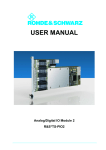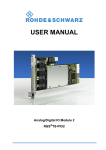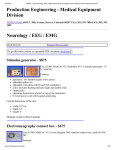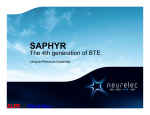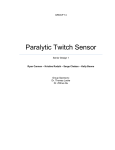Download Accurate Technology Digi-Stop Instruction manual
Transcript
Neuro Technology, Inc. Instruction Manual for DigiStim III Peripheral Nerve Stimulator Part Number: 8-1002-10 TABLE OF CONTENTS 1. INTRODUCTION 2. SETUP 3. FAMILIARIZATION WITH CONTROLS 4. INDICATORS 5. OUTPUT JACKS 6. BATTERY REPLACEMENT 7. APPLICATION NOTES 8. SPECIAL CONSIDERATIONS AND CONTRAINDICATIONS 9. SPECIFICATIONS 1.0 INTRODUCTION This manual is provided to aid the Anesthesiologists/CRNA in the operation of a Peripheral Nerve Stimulator (PNS). 1.1 The DIGISTIM III Peripheral Nerve Stimulator is a constant voltage stimulator for monitoring neuromuscular block and evaluating muscle relaxant dosage during surgery and recovery. The instrument can also be used as an aid in accurately locating nerves when performing nerve block procedures. A digital display provides an accurate readout of the current delivered to the patient. 2.0 SETUP 2.1 Location of the instrument should be within six to twelve feet of the patient (depending on leadwire length) and approximately five feet above the floor to provide easy viewing of the touch switches and indicators. The stimulator may be placed on an instrument shelf or attached to an IV pole or anesthesia machine using an optional mounting bracket. 2.2 The leadwires should be attached to the instrument while the numbered control knob is in the OFF position. See Section 7.1 for instructions on the use of gelled electrodes. 3.0 FAMILIARIZATION WITH CONTROLS Power is applied to the instrument by rotating the control knob located on the left side of the case in a clockwise direction until an audible click is heard. When the unit is first turned ON, a random number will appear on the digital display. The instrument is now in the standby mode and no pulses will be generated. When stimulus pulses are generated, the digital display will indicate the amplitude of the current in milliamperes (mA). The numbered control knob is used to adjust the amplitude of the output current. The numbers on the knob serve as a convenient reference for remembering the approximate settings of the output amplitude. 3.1 The eight membrane touch-switches (buttons) located on the front panel provide a convenient means of controlling the functions of the instrument. They are operated by using a finger to depress the desired function designated under each of the eight buttons. Each time a pulse is generated, the Pulse LED will flash and an audible click will be heard. 3.2 The STANDBY button puts the instrument in standby mode in which no stimulus pulses are generated. 3.3 The TEN SEC button when depressed will generate one pulse every 10 seconds continuously. The 10 second pulses can be stopped by depressing the STANDBY button or selecting another function. 3.4 The ONE SEC button when depressed will generate one pulse every second continuously. The 1 second pulses can be stopped by depressing the STANDBY button or selecting another function. 3.5 The TWO HZ button, which is used primarily for nerve location, will cause a pulse to be generated at ½ second intervals continuously. The 2 Hz pulses can be stopped by depressing the STANDBY button or selecting another function. 3.6 The 100 HZ TETANUS button is momentary and will deliver 100 pulses per second as long as the button is depressed. 3.7 The 50 HZ TETANUS button is momentary and will deliver 50 pulses per second as long as the button is depressed. 3.8 The TOF (Train-Of-Four) button when depressed will automatically generate four pulses in a period of two seconds. The train-of-four pulses will be repeated every ten seconds until the STANDBY button is depressed or another function is selected. The train-of-four pulses can be repeated as often as one wishes without waiting for ten seconds. Immediately after the train-of-four pulses, depress the STANDBY button and then the TOF button again. This cycle can be repeated as often as needed. 3.9 The BATTERY button when depressed will display the voltage of the battery on the digital display. This enables the user to check the condition of the battery before using the instrument. The instrument will function properly when the battery voltage is in the range of 7.0 to 9.5 volts. 4.0 INDICATORS 4.1 The Pulse LED will flash RED each time an output stimulus pulse is generated. It is located to the right of the digital display and is labeled as Pulse. 4.2 An audible click will be heard each time an output stimulus pulse is generated. This enables the user to verify that the unit is stimulating without observing the Pulse LED. 4.3 The Battery Voltage will be indicated on the digital display when the Battery button is depressed. See Section 6.0 for battery replacement. 4.4 The digital display is a three digit liquid crystal display (LCD) that displays the current delivered to the patient in milliamperes (mA). Knowing the precise current setting is important in applications such as nerve locating or detecting fault conditions. Since the digital display measures the actual current delivered to the patient, a number of fault conditions can be detected by observing the LCD. One fault condition is a broken leadwire. Since current cannot flow through an open circuit, any leadwire which breaks connection with the patient will cause the digital display to indicate all zeroes (i.e. no current flowing to the patient). This is an important feature because a total lack of twitch of the hand due to a broken leadwire could mislead the anesthesiologist to believe that the patient is 100% blocked. A quick glance at the digital display can confirm what is happening and significantly add to the anesthesiologist's confidence that a proper connection is made with the patient. A second fault condition is shorted leadwires. A large increase in the current displayed could indicate that the leadwires are shorted together, possibly due to the alligator clips touching or the gell from the gelled pads flowing together. A shorted leadwire causes the current to bypass the patient and even though the current displayed is higher, the patient may not be receiving sufficient stimulus. The end result of shorted leadwires is the same as broken leadwires which is no or greatly reduced twitch response. 5.0 OUTPUT JACKS 5.1 There are three output jacks located on the rear panel of the instrument case. Their colors are RED (HI), BLACK (COM) and YELLOW (LO). 5.2 The common output jack is BLACK (COM). This is the negative output and should always be connected to the leadwire with the BLACK plug. It is labeled as COM. 5.3 The RED (HI) jack is the high positive output. The leadwire with the RED plug should be connected to the RED (HI) jack for use with gelled electrodes. This output can deliver (with a fresh battery) approximately 70 mA into a 2000 Ohm load. It is labeled as HI. The HI output should never be used with a needle electrode. 5.4 The YELLOW (LO) jack is the low positive output and is used with a needle electrode when performing nerve block procedures. The low output can deliver up to approximately 6 mA into a 2000 Ohm load. An important feature of the low output is that one is able to select precise current settings in 0.1 mA increments. It is labeled as LO. 6.0 BATTERY REPLACEMENT The battery is easily replaced by turning the instrument over and removing the battery cover, unsnapping the old battery and snapping in a fresh one. The battery should always be replaced with a 9 volt alkaline battery. Battery voltage can be monitored by depressing the Battery button on the front panel and observing the voltage indicated on the digital display. Although the instrument will operate satisfactorily down to approximately 6.5 volts, the stimulus output current decreases rapidly below this voltage. Therefore, the battery should be replaced at a voltage level no lower than 6.5 volts. 7.0 APPLICATION NOTES (monitoring of neuromuscular function) 7.1 LEADWIRE ATTACHMENT WHEN USING GELLED ELECTRODES The leadwire with the BLACK plugs should be plugged into the BLACK (COM) jack located on the rear panel of the instrument and the leadwire with the RED plugs should be plugged into the RED (HI) jack located adjacent to the BLACK (COM) jack. Gelled electrodes should be placed in line with and over the ulnar nerve. The distal (negative) electrode should be placed at the level of the proximal flexor crease of the wrist. The electrode pair should be placed directly over and parallel to the flexor carpri ulnaris tendon. 7.2 BASELINE ADJUSTMENT Before any muscle relaxant is administered, the instrument should be adjusted to provide Supramaximal Stimulation (SMS). SMS is defined as the level at which additional stimulation current does not increase twitch response. This setting can be approximated by adjusting the control knob to the level where any further increase in stimulus current would not increase the level of the twitch response. Note the reading on the digital display and maintain this baseline setting throughout the entire procedure. 7.3 TWITCH RESPONSE The simplest test provided by the PNS is the twitch response where individual stimuli are generated at intervals of one to ten seconds. Shortly after administering the muscle relaxant, the twitch response will start to become depressed. At this point more than 70 percent of the receptors should be blocked. When the twitch is completely eliminated, greater than 90 percent of the receptors are occupied by the relaxant. The twitch can be used as a quantitative monitor by adjusting the muscle relaxant administration to maintain a faint, but perceptible muscular contraction (twitch) in response to the PNS. This assures adequate operating conditions while avoiding excessive relaxant administration. In the event the twitch has been abolished by an inadvertent relaxant overdose, if one waits until the twitch reappears before administering subsequent relaxant, the incidence of failure of reversal can be minimized. 7.4 TETANIC STIMULI When the single twitch response has returned to normal, approximately 20 percent of the receptor pool is free. Fortunately, the diaphragm needs fewer receptors available to respond normally than do peripheral muscles. This can be observed clinically in that spontaneous respiration may be detected before an indirectly stimulated response. However, a patient with 80 percent receptor block may still need to be carefully monitored. Thus, it is important to have a means of assessing when recovery has proceeded to a more adequate level. It was to this end that the tetanic stimuli evolved. This is the administration of 50 or 100 Hz stimuli for a period of approximately 5 seconds duration. The higher frequency puts a greater demand on the neuromuscular synapse because as each successive stimulus arrives at the nerve ending, it depletes the local store of transmitters so that the amount of acetylcholine available for release by each succeeding stimulus falls. When the fraction of free receptors is also decreased, the tetanic response does not maintain its initial intensity; it fades. The higher the rate of tetanic stimulation, the more sensitive the test. Fade can be detected at 100 Hz when as few as 50 percent of the receptors are occupied and at 50 Hz when as few as 70 percent of the receptors are occupied. Unfortunately, tetanic stimuli are painful and are therefore of limited value in detecting subtle neuromuscular blockade in the unanesthetized patient. 7.5 TRAIN-OF-FOUR In the Train-Of-Four (TOF) test, the ulnar nerve is stimulated with four supramaximal stimuli 0.5 second apart and the ratio of the fourth twitch to the first twitch is used to determine the degree of neuromuscular block. The primary advantage of TOF is that the first response provides a built-in control for the fourth response. Built-in control is a great convenience in the clinical setting in which factors such as patient movement can change the initial tension of the muscle and hence the amplitude of the twitch response. A good rule of thumb is that the degree of block may be estimated by counting the number of twitches seen following the four stimulus pulses. When only one twitch is present, there is greater than 90 percent block. All four twitches appear when the single twitch is depressed by 75 percent. Recovery from the block occurs when all four twitches in the train are the same height. At this time, about 25 percent of the receptor pool is free. Thus, TOF is a slightly more sensitive test than the twitch. 7.6 NERVE BLOCK PROCEDURES The PNS can be used as an aid in locating any nerve that has a motor component, but is not a substitute for knowledge of basic anatomy and block technique. The basic technique of locating nerves using a PNS is outlined in the following paragraphs. It is important to observe the digital display of the output current since the accuracy of nerve location depends on how precisely the current can be set. The lower the current setting, the closer the needle must be to the nerve to obtain a motor response. CAUTION: Do not use the RED (HI) output jack for nerve location. Stimulation of nerves using needles requires very low current. Use of the RED (HI) output may result in possible needle burns. The leadwire with the BLACK plug should be attached to the BLACK (COM) jack on the rear panel of the instrument and the leadwire with the RED plug should be attached to the YELLOW (LO) jack adjacent to the BLACK (COM) jack. Short the leadwires together by attaching the alligator clips to each other. Turn the instrument ON and depress the TWO HZ button. Adjust the amplitude control knob on the side of the instrument until the digital display reads 3.0 mA. This confirms that the instrument is operating properly and also sets the current control knob to approximately the correct position. Disconnect the alligator clips from each other and attach the negative leadwire (BLACK alligator clip) to the block needle (BD STIMEXtm insulated needle or eqivalent). Connect the positive leadwire (RED alligator clip) to a gelled electrode placed on the trunk of the body some distance from the block site to minimize direct stimulation of local muscles. Following local anesthetic infiltration of the skin, the needle should be inserted in the normal manner for the particular block being performed. Begin advancing the needle, and if necessary, readjust the current to within the 2 to 3 mA range. Continue advancing the needle until a motor response is obtained. Reduce the current until the motor response is barely perceptible and then advance or withdraw the needle to maximize the response. Continue this technique until a motor response is obtained at 1 mA or less. It should be possible to obtain a motor response at 0.5 mA. 8.0 SPECIAL CONSIDERATIONS AND CONTRAINDICATIONS 8.1 EXPLOSIVE ATMOSPHERES This device is a possible explosion hazard if used in the presence of flammable anesthetic gases. 8.2 MICROSHOCK HAZARD This device may be hazardous to patients with pacing catheters. If used on such patients, exercise extreme caution to prevent the nerve stimulator output leadwires from contacting the pacing catheter or catheter leadwires. Patients with an implanted electronic device (for example a cardiac pacemaker) or cardiac abnormalities should not be subjected to stimulation unless a specialist’s medical opinion has first been obtained. 8.3 NEEDLE ELECTRODES Because of the small surface area and low current values required when using percutaneous (needle) electrodes and the potential for high current density and possible needle burns, it is recommended that only the YELLOW (LO) and BLACK (COM) output jacks be used when locating nerves. The HI output should never be used with a needle electrode. 8.4 USE WITH H.F. SURGICAL EQUIPMENT Simultaneous connection of a patient to h.f. surgical equipment (i.e. electrocautery/electrosurgical units) may result in the electronic gating mechanisms in the nerve stimulator being overridden by the cautery pulses causing stimulus pulses to be generated by the stimulator. Simultaneous connection may also result in burns at the site of the stimulator electrodes and possible damage to the stimulator. 8.5 USE WITH SHORTWAVE OR MICROWAVE THERAPY EQUIPMENT Operation in close proximity to a shortwave or microwave therapy unit may produce instability in the stimulator output. 8.6 SKIN BURNS Use of tetanic stimulation for prolonged periods of time may result in skin burns. The stimulus current should be gradually increased until supramaximal stimulation is achieved. Use of current levels higher than required for supramaximal stimulation increases the risk of skin burns. 8.7 TETANIC STIMULATION Tetanic stimulation may be uncomfortable for fully conscious patients. Therefore, it is recommended that twitch or trainof- four be used which are better tolerated in awake patients. 9.0 SPECIFICATIONS 9.1 BUTTON FUNCTION FREQUENCY Standby………………………………No stimulus pulses are generated Ten Sec………………………………1 pulse every 10 seconds One Sec………………………………1 pulse per second Two HZ..……………………………..2 pulses per second 100 Hz Tetanus………………….100 pulses per second 50 Hz Tetanus..………………….50 pulses per second TOF (Train-Of-Four)………………..4 pulses per 2 seconds. Repeats every 10 seconds Battery……………………………….Displays Battery Voltage 9.2 PULSE CHARACTERISTICS Pulse Width…………………………...200 Microseconds Pulse Type…………………………….Square Wave Monophasic 9.3 OUTPUT CURRENT RED (HI) output……………………………….0 - 70 mA YELLOW (LO) output…………………………0 - 6 mA 9.4 DISPLAY/LED/AUDIBLE INDICATORS Digital Display: Displays amount of current in mA delivered to the patient. Resolution of the display is 0.1 mA / 0.1 Volt. Also, displays battery voltage when the battery button is depressed. Pulse LED: Flashes RED each time a pulse is generated. Stimulus Pulse: An audible click will be heard each time a stimulus pulse is generated. 9.5 POWER: One nine volt alkaline battery. 9.6 POWER CONSUMPTION: Approximately 7.6 mA 9.7 CASE: High impact ABS plastic 9.8 SIZE: 2.09”H x 3.60”W x 5.75”D 9.9 WEIGHT: 11 oz. Including battery. 10.0 STERILITY: Non-Sterile 11.0 SERVICE LIFE: The service life of this device is 3 years from date of purchase. Limited Warranty Neuro Technology, Inc. products are guaranteed against defects in materials and/or workmanship when used in normal service for One Year from date of delivery to the original purchaser. Adjustment and/or repair without charge will be made during the one year warranty period only if the instrument in question has not been abused, tampered with, or subjected to unauthorized repair. Damage due to fire, lightning, negligence, water and other liquids, excessive pressure or misuse are not covered under this warranty. Warranty inquiries and requests for warranty repair should be made directly to: Mainline Medical Inc. 3250-J Peachtree Corners Circle Norcross, Georgia 30092-4301 Tel: (800) 366-2084 • (770) 409-2800 Fax: (800) 261-3066 • (770) 409-1414 Website: mainlinemedical.com Email: [email protected]





